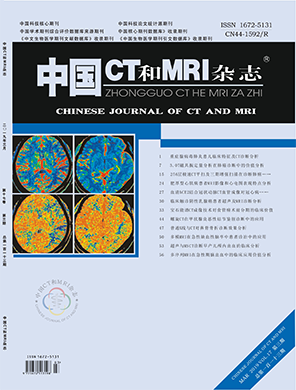摘要
目的 探讨MRI和CT联合定位诊断 22例癫痫的价值及影像特征分析。方法 选择2016年6月至2018年6月在我院神经外 科就诊的癫痫患者66例进行回顾性分析, 其中22例进行MRI和CT诊断,观察两种诊 断方式的影像学特征及联合诊断与术中皮 质脑电图(ECoG)诊断符合率。结果 66例 病人MRI检查结果12例为单纯海马萎缩硬 化,10例为单纯杏仁核信号增强,海马硬 化合并其他病变中脑萎缩、软化灶病变较 为常见,其他病变中胶质增生较为常见, 且18例患者MRI检查结果无异常。22例患 者进行PET-CT检查,其中常见病灶部位为 单侧广泛代谢区7例。MRI、PET-CT联合检 查与术中ECoC检查符合率72.73%,进行卡 方检验差异有统计学意义(P<0.05)。结 论 MRI和CT诊断定位部位各不相同,其中 MRI对海马/杏仁核诊断较为可靠,CT可以 提供更多定位信息,两者优势互补,联合 检查符合率较高。
Objective To investigate the value and imaging features of MRI and CT in localization diagnosis of 22 patients with epilepsy. Methods A retrospective analysis was performed on 66 patients with epilepsy who were treated in neurosurgery department of the hospital during the period from June 2016 to June 2018. Twenty-two patients were diagnosed by MRI and CT. Imaging features of the two diagnostic methods and the coincidence rate of combined diagnosis with electrocorticography (ECoG) were observed. Results Of the 66 patients, MRI showed that 12 patients had simple hippocampal atrophy and sclerosis, and 10 patients had simple enhanced signal of amygdala. For hippocampal sclerosis combined with other lesions, brain atrophy and softening lesions were more common. Glial hyperplasia was more common in other lesions. There were no abnormalities in MRI findings of 18 patients. Twenty-two patients underwent PET-CT, and the common lesions were located at unilateral extensive metabolism zone of 7 patients. The coincidence rate of MRI combined with PET-CT with intraoperative ECoC was 72.73%. Chi-square test showed that the difference was statistically significant (P<0.05). Conclusion The location of MRI and CT diagnosis is different. MRI is more reliable for the diagnosis of hippocampus/amygdala. CT can provide more localization information. The advantages of the two are complementary, and the coincidence rate of combined examination is higher.
【关键词】磁共振成像;CT;癫痫;定位
【中图分类号】R74;R65
【文献标识码】A
【DOI】 10.3969/j.issn.1672- 5131.2019.03.024
前言
癫痫是一种由多种原因导致的慢性脑功能障碍,是脑神经元反复 同步化引起的脑功能紊乱,由于异常神经元部位和放电部位各不相 同,患者临床表现为短暂性神经系统障碍,包括感觉、行为、意识及 运动等。流行病学调查研究发现,我国癫痫患者约在900万人以上, 且以每年40~60万数量呈持续上升趋势,随着各种新型抗癫痫药物问 世,新发患者仍有30%~40%左右,严重威胁着人们生命健康[1-2]。目前 临床上对癫痫鉴别诊断“金标准”为脑电图,随着近年各种定位技术 的飞速发展,目前主要使用的诊断方法有神经影像学检查、核医学检 查及神经电生理学检查,分别为高分辨磁共振(MRI)、正电子发射计算 机断层显像(PET-CT)及脑电图。大量临床研究证实,在患者手术前放 置颅内硬膜外或硬膜下皮层脑电图(ECoC)分辨率较高,且干扰极少, 可以准确判断癫痫放电起始区域及扩散过程[3]。本文主要比较MRI和CT 联合运用与术中ECoC定位的符合率,并探讨术前无创检查在癫痫定位 上使用价值及影像特征分析,现将研究结果报道如下。
中国CT和MRI杂志
第17卷, 第 3 期
2019年03月

相关文章